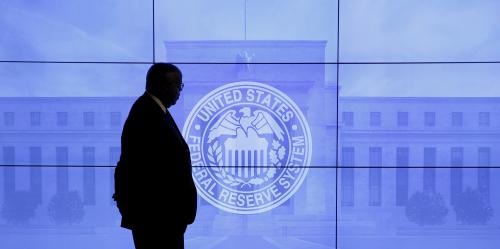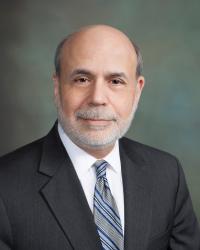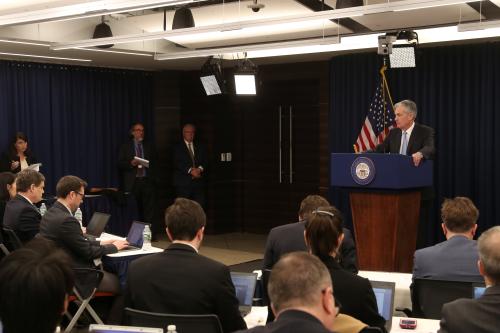On Wednesday, November 30, I’ll be participating as a panelist in an event on Fed communications at the Hutchins Center on Fiscal and Monetary Policy at Brookings. My former Fed colleague Jon Faust will present a keynote paper, and Fed governor Jay Powell will speak as well. We will also hear about a survey of academic and market participant views of Fed communication, conducted by the Hutchins Center.
Faust’s paper and the Hutchins survey take a generally positive view of the subset of Fed communications that aim to reflect the collective view of the Federal Open Market Committee (FOMC), such as the post-meeting statement, the chair’s press conferences and testimonies, and the minutes. However, they are generally more critical of the “decentralized” communication of the views of individual FOMC participants, including speeches by governors and Reserve Bank presidents and the FOMC’s quarterly Summary of Economic Projections (SEP), which collects projections by individual participants of economic growth, unemployment, inflation, and interest rates. A common complaint is that the volume of such communication is “cacophonous.” Faust argues that, in addition, speeches by FOMC participants and the SEP are not particularly useful to analysts trying to divine how monetary policy will respond to economic developments (the FOMC’s “reaction function”).
I have some sympathy with the “cacophony” complaint. The FOMC is a large and diverse committee, and the incentives that individual governors and presidents have to speak publicly about monetary policy probably don’t add up to an optimal communication strategy for the committee as a whole. In particular, the tendency of individual FOMC participants to make public forecasts of what the committee as a whole is likely to do (as opposed to what they themselves see as the best policy approach) is not helpful. On the other hand, as I discuss here, policy communications by individual FOMC participants are not just about influencing market expectations—they serve a number of other important functions, including providing further explanation and discussion of the issues at stake in policy decisions, encouraging outsider input, and providing assurance to the public that diverse points of view are represented in the policy debate.
The individual views of FOMC participants are also reflected in the Summary of Economic Projections. I’ll argue in the remainder of this post that the SEP can be a useful tool for Fed-watchers, but only if they appreciate how it is constructed and what it does and does not represent.
What is the Summary of Economic Projections?
Four times each year, just prior to an FOMC meeting, the nineteen FOMC participants (seven Board governors when there are no vacancies, 12 Reserve Bank presidents) submit projections for four key economic variables—real output growth, the unemployment rate, overall inflation, and core inflation (excluding prices of food and energy)—and for short-term interest rates.[1] Projections cover the current year and up to three additional years (so, for example, the projections made in September 2016 are for full year 2016 as well as for 2017, 2018, and 2019). Projections are also made for the “long run” values of the variables—the values to which the variables would be expected to converge over time if, hypothetically, there were no new shocks to the economy. Importantly, projections are conditioned on each participant’s individual view of what would be “appropriate” monetary policy, defined as the policy that the individual believes would be most likely to help achieve the Fed’s inflation and employment objectives. So, when projecting the behavior of (say) inflation, a hawkish member of the committee might be assuming a very different future path of interest rates than a dovish member.
The Fed publishes summaries of the projections, without attribution to individual participants. All the interest-rate projections for current and future years are shown in a figure, known to Fed-watchers as the “dot plot.”

The SEP is released shortly after the conclusion of the meeting, and then discussed by the chair in the press conference. (Indeed, the original rationale for holding chair press conferences quarterly was to coordinate with the release of the SEP.) The minutes of the meeting, released three weeks later, contain additional information, including more details on the projections and participants’ risk assessments, and a summary of qualitative comments submitted by participants along with their numerical projections.
The Fed has compiled policymakers’ economic projections for some time. For example, when I joined the Committee as a governor in 2002, the Board’s semi-annual Monetary Policy Report already included FOMC projections of nominal GDP growth, real GDP growth, inflation, and unemployment for the current and subsequent year. Since then, however, as part of the committee’s efforts to increase policy transparency, the projections were made quarterly and expanded both to cover more years (and the “long run”) and to include projections of policy interest rates as well as macro variables.
What the SEP is not
To make use of the SEP, Fed-watchers must appreciate what the SEP is not:
1. The SEP is not a policy commitment by the FOMC
The projections reported in the SEP, including of course the interest-rate projections, are submitted by individual FOMC participants in a decentralized way. The projections do not necessarily reflect the FOMC consensus and they certainly do not bind future FOMC actions. If the FOMC as a whole is going to make a commitment or provide explicit guidance about future rate policy, it will do that in its post-meeting statement, or the chair will communicate it.
2. The SEP is not an unconditional economic forecast
An economist making a forecast will put down what he thinks is likely to happen, taking as given his best guesses about policy and other factors. That’s not what an FOMC participant is doing when she submits a projection. Remember that projections are supposed to be based on individual views of “appropriate monetary policy.” Consider, for example, a hawk who believes that the policy supported by the FOMC consensus is too dovish. Her forecast of what will actually happen would be that interest rates will remain low and that inflation will as a consequence exceed the Fed’s target. However, her projections for the SEP will instead reflect what she would do, counterfactually, if she were in charge—higher rates than she expects to see, and inflation closer to target. (Of course, the views of individual participants do carry some information about what the FOMC is likely to do, as I elaborate below.)
3. The SEP does not capture statistical uncertainty or the range of possible outcomes
SEP projections are explicitly of the “most likely” or modal outcomes rather than the range of possible scenarios. One implication: In recent years, the FOMC has indicated that it sees “downside risks” to its outlook for jobs and inflation, meaning that scenarios in which interest rates remain lower than in its central projection have been seen as more likely than higher rate scenarios. Taking into account the full range of possible outcomes, when downside risks dominate, the average, or mean, future path of interest rates is lower than the modal, or most likely path. Since bond traders care more about the mean path, which reflects the full range of possible outcomes, the mode-mean distinction can partly explain why SEP projections of future interest rates have been higher in recent years than market-implied rates.[2] More generally, we know that the statistical uncertainty associated with any macroeconomic projection is very high; SEP projections are no exception and should accordingly be treated with great caution.
What the SEP is good for
So what information does the SEP provide? I’d point to three areas:
1. The SEP is a straw vote
The FOMC is not a simple democracy but a consensus-driven organization, with the agenda set by the chair. Only twelve of nineteen participants have a vote at each meeting. Consequently, it is not straightforward to infer FOMC policy by looking at the median SEP projection of rates or other variables, without benefit of other information. Still, in conjunction with speeches and other public comments, the SEP does provide timely quantitative information about the range of views on the committee and how the thinking of participants is evolving. I think of the SEP as a straw vote, a reflection of the range of sentiment going into the full committee debate.
Does the SEP straw vote predict actual FOMC decisions? Interest-rate projections in particular are still a relatively recent innovation, so the data seem insufficient at this point to give a clear answer to that question. The SEP released after the September FOMC meeting showed a strong majority of committee participants (all but three) expecting another rate increase this year, and an increase does seem likely for December. On the other hand, recently, SEP rate projections over longer horizons have been too optimistic about the ability of the economy to sustain rate increases (for example, as of a year ago many participants saw four rate increases in 2016). As discussed further below, however, I believe that discrepancy is explained by systematic changes in participants’ outlooks in light of new economic information, not by the failure of the SEP to capture the range of views at a particular moment in time.
2. The SEP provides information about key long-run parameters
The FOMC introduced its formal inflation target only in 2012, but for several years before that it effectively communicated its inflation target through the SEP. With virtually all participants projecting 2 percent inflation in the long run, under the assumption of appropriate monetary policy, it was clear that the committee had agreed on where it wanted to steer inflation over time. As I discussed here, other key long-run parameters about which the SEP is informative include the so-called natural rate of unemployment (the rate of unemployment consistent with stable inflation); the potential output growth rate; and the “neutral” or equilibrium value of the federal funds rate, which correspond to the long-run projections of unemployment, output growth, and the funds rate, respectively. In the absence of official FOMC estimates of these critical variables, the SEP provides the best available information on participants’ views.
3. The SEP provides indirect information about the FOMC reaction’s function
As Jon Faust argues in his paper for the Hutchins Center conference, the individual participant views captured by the SEP do not aggregate in a straightforward way to FOMC decisions. Still, in contrast to Jon, I think that—properly interpreted—the SEP provides useful quantitative information about the FOMC’s reaction function, and, in particular, why the projections of future interest rates change over time. For example, as I argued here, the downward shift of the FOMC’s projected rate path over the past couple of years, rather than being arbitrary or the product of temporary market pressures, can largely be explained by participants’ changing views of key economic parameters, notably the equilibrium federal funds rate and the natural rate of unemployment, as revealed by the SEP. A recent piece from the San Francisco Fed shows that shifts in the outlook and in estimates of key parameters reflected in the SEP fully explain the revision in median interest rate projections between December 2015 and September 2016.
Wouldn’t it be easier if the FOMC just provided its reaction function, together with collective projections of key macro variables? In principle, yes; and in fact, in the course of expanding the SEP, the FOMC under my chairmanship experimented with developing a consensus committee forecast, together with alternative scenarios, that could be released to the public. However, given the large size of the committee and the disparate views represented, we were unable to agree on a procedure for developing such a forecast in a timely way. In short, the committee faced the same problems in aggregating the wide range of participants’ views that outside analysts confront when interpreting the SEP.
Conclusion
The Summary of Economic Projections remains a controversial part of the Fed’s communications toolkit, and it has sometimes confused more than enlightened. The FOMC should continue to look for improvements, ranging from the marginal (a better accounting for uncertainty and alternative scenarios, for example) to the more fundamental (a possible revisiting of the idea of developing a collective committee forecast). That said, in its current form the SEP does provide useful information about the views of FOMC participants and the factors that condition their policy preferences.
[1] Some of the gap may also be explained by the low, possibly negative risk premiums in bond markets, which depress longer-term interest rates relative to expectations of how short-term interest rates are likely to evolve in the future.
[2] Currently, with two Board seats vacant, there are only seventeen FOMC participants. Projections are submitted after participants see the staff economic forecast, which tends to be influential. Otherwise, however, there is no or very little coordination among participants in their submissions. In principle, participants can revise their projection any time up until the end of the FOMC meeting, but revisions are rarely made.
Comments are now closed for this post.
The Brookings Institution is committed to quality, independence, and impact.
We are supported by a diverse array of funders. In line with our values and policies, each Brookings publication represents the sole views of its author(s).







Commentary
Federal Reserve economic projections: What are they good for?
November 28, 2016